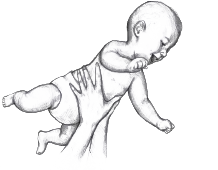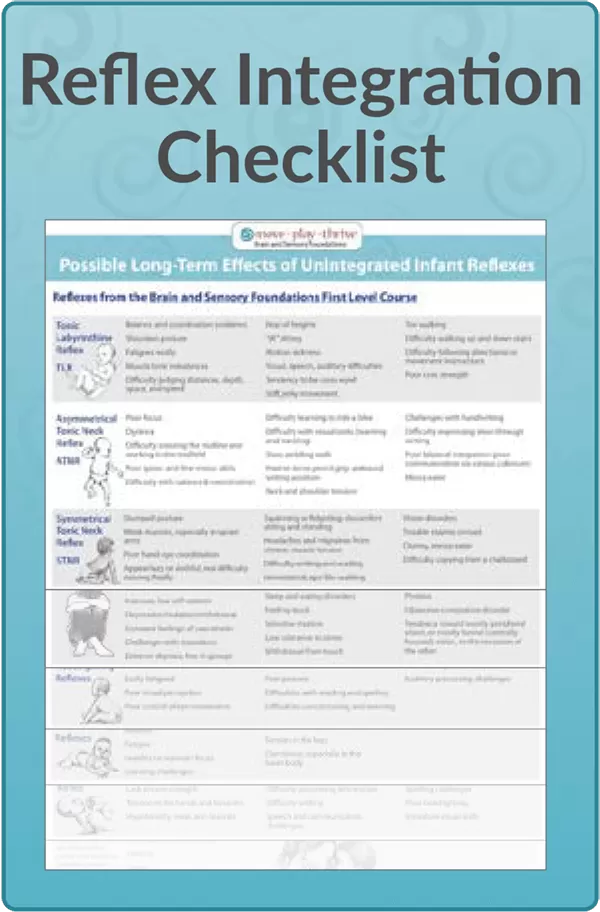Landau Reflex
 The Landau reflex, sometimes called the “flying reflex”, is stimulated when the infant is in prone or held in ventral suspension, and is crucial for developing core strength. It begins emerging at approximately 4 weeks of age, when a prone infant starts lifting the head up against gravity. By 2 months of age infants are ideally able to lift the chest along with the head, and begin using the arms. The full Landau pattern of lifting the head, chest, and all four limbs—as if flying—should be in place by 6 months.
The Landau reflex, sometimes called the “flying reflex”, is stimulated when the infant is in prone or held in ventral suspension, and is crucial for developing core strength. It begins emerging at approximately 4 weeks of age, when a prone infant starts lifting the head up against gravity. By 2 months of age infants are ideally able to lift the chest along with the head, and begin using the arms. The full Landau pattern of lifting the head, chest, and all four limbs—as if flying—should be in place by 6 months.
The limbs automatically extending along with the head is an example of body parts being linked together by reflex activity. In infancy this is appropriate and helps to develop the body and sensory systems. The Landau reflex enhances balance, stability, core strength, and visual processing. It is essential for our anti-gravity development and helps to complete the integration of the Tonic Labyrinthine Reflex, the Symmetrical Tonic Neck Reflex, and the Headrighting reflexes. Landau is ideally integrated no later than 3 years of age and replaced with voluntary, independent movements of the head and limbs.
Infants receive a tremendous amount of sensory and brain stimulation from engaging in the Landau reflex. In order for the Landau reflex to develop and integrate however, an infant must spend substantial time in prone. Lying in supine does not provide the required sensory input for optimal development.
If the Landau remains unintegrated beyond age 3, it is associated with physical, cognitive, and emotional challenges, including depression. Many individuals with depression have a retained Landau, and it is likely that poor core strength and posture—i.e. difficulty lifting the body up against gravity, resulting in physical stress—contribute to a “down” emotional state.
Possible Long-Term Effects of an Unintegrated Landau:
- Weak core
- Lack of core organization
- Poor coordination of upper and lower body
- Excess tension in the back
- Difficulty maintaining upright posture
- Balance issues
- Clumsiness
- Inability to fully integrate TLR, STNR, and Headrighting
- Sensory processing issues
- Learning and attention challenges
- Easily frustrated
- Depression
- Amphibian Reflex
- Asymmetrical Tonic Neck Reflex
- Birth and Bonding
- Crawling Reflexes
- Crossed Extensor Reflex
- Facial-Oral Reflexes
- Fear Paralysis Reflex
- Feet Reflexes—Plantar & Babkinski
- Foot Tendon Guard
- Hand Reflexes—Grasp, Palmar, and Babkin
- Headrighting Reflexes
- Infant Torticollis
- Landau Reflex
- Moro Reflex
- Parachute Reflex
- Pull-to-Sit Reflex
- Spinal Galant Reflex
- Spinal Perez Reflex
- Symmetrical Tonic Neck Reflex
- Tonic Labyrinthine Reflex
Sources
Goddard Blythe, S. (2023). Reflexes, movement, learning & behavior. Analysing and unblocking neuro-motor immaturity. Hawthorn Press.
Masgutova, S. (2007). Integration of infant dynamic and postural reflex patterns: Neuro-sensory-motor and reflex integration method [Training manual].
Masgutova, S. (2008, July 27-August 3). MNRI Family Workshop Clinic [Lecture]. Newark, New Jersey
Porter, K. (2017). Healthy posture for babies and children: Tools for helping children to sit, stand, and walk naturally. Healing Arts Press.


